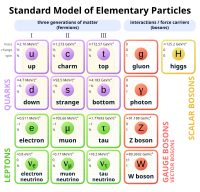
Photo from wikipedia
Abstract We investigate an extension of the Standard Model (SM) with two candidates for dark matter (DM). One of them is a real scalar field and the other is an… Click to show full abstract
Abstract We investigate an extension of the Standard Model (SM) with two candidates for dark matter (DM). One of them is a real scalar field and the other is an Abelian gauge field. Except for these two, there is another beyond SM field which has unit charge under a dark UD(1) gauge symmetry. The model is classically scale invariant and the electroweak symmetry breaks because of the loop effects. Although SM is extended with a new dark symmetry and three fields, because of scale invariance, the parameter space is strictly restricted compared to other two-component DM models. We study both DM phenomenology and electroweak phase transition and show that there are some points in the parameter space of the model consistent with DM relic density and direct detection constraints, while at the same time can lead to first order electroweak phase transition. The gravitational waves produced during the phase transition could be probed by future space-based interferometers such as Laser Interferometer Space Antenna (LISA) and Big Bang Observer (BBO).
Journal Title: Journal of High Energy Physics
Year Published: 2022
Link to full text (if available)
Share on Social Media: Sign Up to like & get
recommendations!